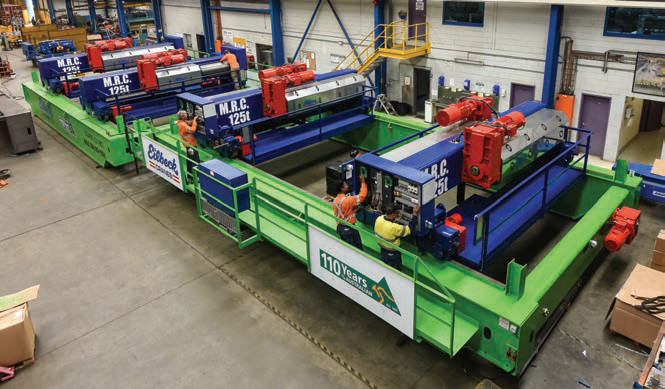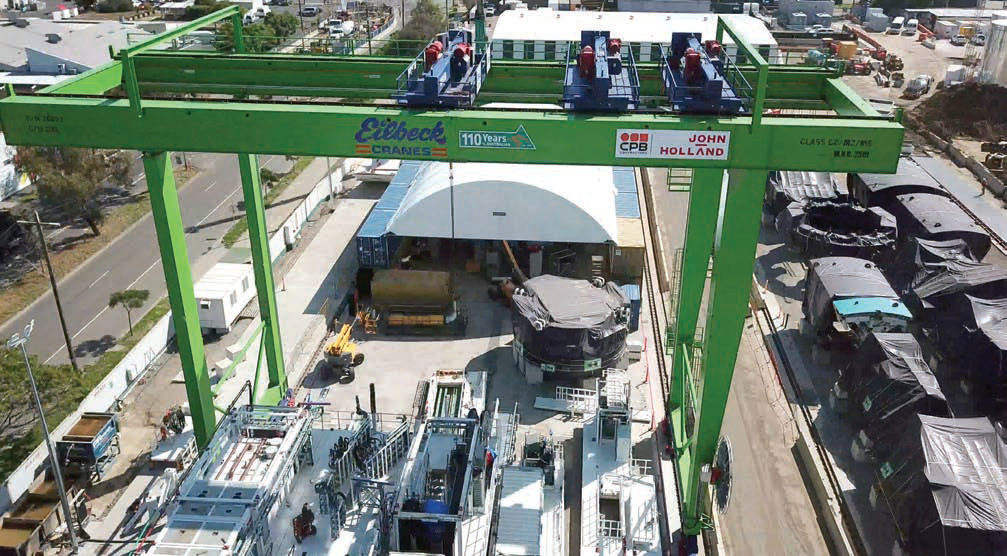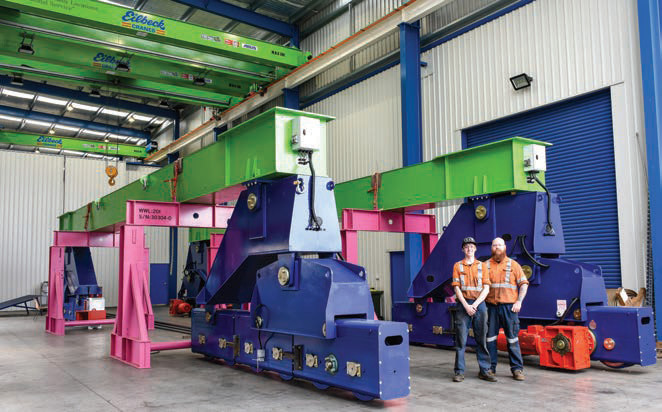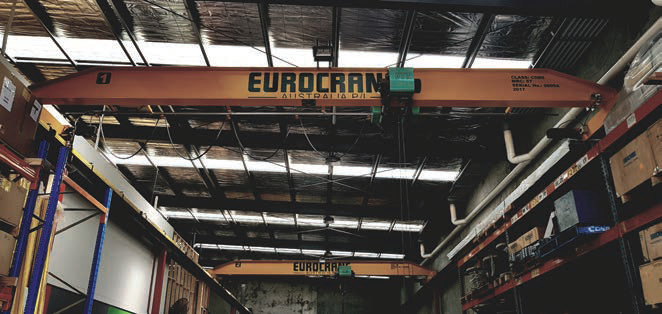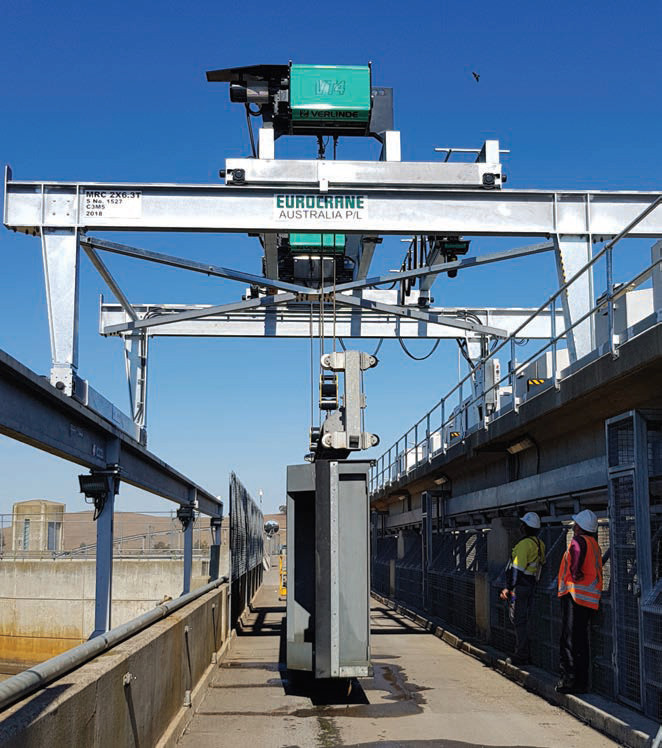Going up down under
8 August 2019The crane market in Oceania has been going through hard times. But Julian Champkin finds an air of anticipation and a refusal to give in.
It is almost two years since anyone last produced a car in Australia. Holden, the home-grown manufacturer who made among other things the iconic Ute, or Utility Vehicle—half car with family in the front, half pickup truck with sheepdog in the back—had become a brand of General Motors. It closed down its production line in October 2017.
“Toyota and Ford had already left,” says Colin Smith, managing director of JDN Monocrane, Victoria-based designers and makers of cranes and hoists. “Mitsubishi withdrew some years before that. All cars in Australia are now imported.”
Those vehicle makers all considered Australian labour costs too high and the Australian and New Zealand consumer market too small to sustain manufacturing there.
“It left a hole,” says Bruce McKay, director of Global Track Australia, who make light gantry hoists, “and nothing has filled that hole. The Holden works stood empty for almost two years.”
Cars and cranes are connected. The car industry can be an indicator for manufacturing generally; the mass exodus was not, on the face of it, an encouraging bit of history for suppliers of hoists and lifting gear to any kind of factory.
James Schmidt is engineering manager of Sam Technology, makers of materials handling and lifting equipment. “Manufacturing in Australia is dead,” he says. “In Sydney, Melbourne, Brisbane, overheads and land costs are huge. The government does not encourage manufacture. Infrastructure and mining are what is left. Supply those as a crane manufacturer and you can get by. Otherwise you are…” we can finish his sentence politely by saying ‘... in trouble.’
Though even for crane-makers to the infrastructure and mining industries there are problems. “Mining has been dead as well, for six or seven years,” says Philip Heinrichson, of hoist-makers Eilbeck Cranes. “It is beginning to re-start now, but there are Australians who want to ban mining.” He is referring, among other things, to the controversy over the new, and giant, Adani open-cast coalmine in Queensland, which split the country before getting government permission to go ahead.
Schmidt of Sam Technology offers a final crane-maker’s warning of doom. “There is a little place called China,” he says. And China, relatively speaking, is just down the road.
Heinrichson can put numbers to the ‘relatively speaking’: “We in Australia are two weeks by boat from China. In Europe, you are six weeks. So we are the preferred ticket for them.”
Bruce McKay is director of Global Track Australia, who make light gantry hoists. “A client of mine recently bought three jib cranes from China,” he says. “He told me the price; and it was around half of what a locally-made one would be. On the bright side, there is duty on the imports, which makes some difference.”
Eilbeck, Sam Technologies, JDN and Global Track are Australian-owned companies with proud Australian heritage. With high Australian labour costs, and with a source of cheap and possibly cheerful cranes on their doorstep, how do such companies survive?
“Diversification,” says Schmidt of Sam. “We are busy because we make other things as well. And in the lifting market we make special purpose machines. We leave the standard stuff to others.” For Sam, the added value is in bespoke construction for cases where off-the-shelf will not do.
Eilbeck takes another approach. They supply not the specialist but the quality end of the market. As sole importers and distributors of ABUS hoists from Germany, they sell on German engineering—and on Australian self-reliance and pride. “Our company has 17% of the market share,” says Heinrichson. “We are the largest ABUS agents outside Germany. And we have lots of customers. The good quality market is still there. People who buy from us would not be buying cheap Chinese if we weren’t here: the good stuff, which is what they want, is not cheap whoever makes it. There is a fitness and a purpose for all equipment, and you pay for what you get. The back-yard ad-hoc operator will buy Chinese, but he is not part of our natural clientele anyway. The good quality market is still there.”
So, too, is local pride. “We are still rednecks at heart, and we are an island still; which means that people like dealing locally. The real guys still support us.”
Eurocrane, based in Melbourne, is another importer and distributor, in their case specialising in Verlinde hoists from France. Geoffrey Wiart, their technical sales manager, enters the same territory: “The mining industry is indeed very stable, if not slowing down,” he says. “They are not so much our client as they look for cheap—that is, Asian—disposable cranes, and we focus on quality rather than volume. I am not sure if mining will grow soon, but looking at the recent price and demand hike for gold, due to events in Iran and global fear of war, and for rare earths, for electric vehicles and IT, there is a good chance it will pick up again.”
“In terms of technology, generally Australian clients are willing to invest a bit more in the right equipment,” says Wiart. “For them, it is not about getting the cheapest crane. Even so, demand for automation or anti-sway systems remains rare. We do have occasional demand for technically challenging cranes from the aeronautical and nuclear industries and air force and defence. We are starting to be known as the company which says ‘We will do it’ when other say ‘It’s too complicated.’ We usually specialise in special cranes.”
JDN produce the AH, or Australian Hoist, which Colin Smith proudly tells you can come in 2.6 million models. “That is because it is modular,” he says, “with the client able to choose their options. Once you combine speed, drum size, reeving combinations and so on it is like moves in a chess game: a few different moves can produce thousands of different outcomes. I am not saying that we have produced one of each of those two million possible combinations. But it is a significantly large range.
“When the car industry ended, we sat down and crunched the numbers,” he says. “We thought ‘This is going to hurt.’ We could not have been more wrong. The void has been totally filled by other industries.”
He can explain the apparent paradox. “The reality was that the domestic car industry was the least domestic it had ever been. We were not car-makers, we were part of a global car assembly zone. When it ended, all the sub-manufacturers have held on, supplying parts locally.”
“Australia has a more ‘small business’ market,” says Wiart of Eurocranes. “In recent years, most of the heavy manufacturing has moved from Australia, but its isolation has led the Australian to rely on themselves with plenty of small manufacturing to keep crane manufacturers busy.” And he echoes the ‘island mentality ’ theme: “Remember that it takes as long to go to Perth from Melbourne as it would take a Londoner to go to Egypt.”
Colin Smith of JDN again: “Just now the economy is pretty strong. Interest rates are dropping, and they are trying to get more inflation into the system; the Australian dollar is falling, which is helping our exports. So it makes our position a bit strange. We are still building a lot of cranes here.”
With which Heinrichson of Eilbeck fundamentally agrees: “The market is strong in infrastructure and construction. Mining is poised to start going again at any moment.”
Bruce McKay is director of Global Track Australia, who make light gantry hoists. The business has been established for 15 years now. He recently attended a trade fair. “It gave me 60 enquiries to follow up. I usually get 30. I haven’t seen so much interest since 2012. There is work to be done to translate the enquires to sales, but as a rule of thumb I find that around 20% of enquiries turn into sales, which means that we will have 12 jobs coming out if it. Maybe the industry is struggling a bit right now but I would say that the market is steady. It is not way down, because there is work around. A lot of crane companies in the area are doing very well. I am a small business, so I am feeling the pinch, but my gut feeling is that things are starting to move.” He sees areas for growth. “Wind farms have potential,” he says. “There will be specialised lifting equipment for those. They are calling it ‘Gold Wind’ and it is a growing opportunity.” Australia has sunshine—lots of it. “There are some big solar farms. Renewables are getting established now.”
For Eurocranes, it is mainly power, gas and water companies who are the drivers of its business. “They are having difficulties finding suppliers who can actually cover and respect all the relevant standards, and we are gaining a strong reputation for being able to follow them and delivering quality products,” says Wiart. “Manufacturing is not far behind. Mining only get spare parts or small equipment from us.”
Infrastructure is, as we said earlier, another mainstay. Modular Cranes works mainly in Victoria. “There are ups and downs but there are a few projects—mainly roads and tunnels—that are around right now,” says their Agatha Loizu. “They are on the increase, so there is a need for overhead cranes and the like. And last year was good.”
And Australia has been a land of immigration, which still continues:
“The continuous influx of migration continues to maintain a high demand and increasing need for infrastructure, which boosted the economy despite the global crisis which started in 2008,” says Wiart. “In Victoria alone, the government is expending a lot of its money on infrastructure.” The Melbourne Metro Tunnel project is an A$11bn effort. There is the West Gate Tunnel, at A$6.8bn, the Melbourne Airport rail link at $5bn, and the M80 ring road upgrade at A$2.2bn. Nationally funded is the A$9.3 Billion Melbourne to Brisbane Inland Rail. Elsewhere Sydney also has a metro project, this time worth A$12 billion; Queensland has the A$5.4bn Cross River Rail, and the list could continue with half a dozen more. As McKay said earlier, there is work around.
Outside the big projects, business is fairly stable, says Wiart: “Small companies are created every day, and existing clients do not hesitate to upgrade their equipment if the need arises.” Eurocranes are agents for Verlinde, one of whose specialities is entertainment hoists; and entertainment, says Wiart, is one business that remains in constant demand. “It the only stable industry; and with the implementation of the D8+ standard, a lot of our competition finds itself out of the picture.”
Australian standards remain problematic. They do not coincide with European or American ones. “The Australian standards are very similar to the FEM and ISO standards, but with their own twists,” he says. “They basically use the most stringent of foreign standards for certain aspect but disregard others. It even varies from state to state. It is very confusing and many foreign companies, even some other Verlinde agents, try to penetrate the Australian market and every time they lose money when they discover the difficulty of the standards and regulations.”
Eurocranes are fortunate here, says Wiart: “Verlinde is very supportive when it comes to standards. Many of their management team actually set the international standards and sit on the boards. It allows them to know what is coming and they always follow the latest standards. It gives us an edge against our competition.
“The funny thing is that if you dig deep enough in the various standards there is no motor currently manufactured in the world that actually meet all requirements… .”
Despite the difficulties, the Australasian crane market would seem to be getting by. Its problems are not insuperable. All markets go up and down. The market Down Under would seem to be on the verge of an up.